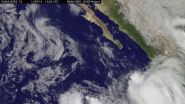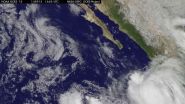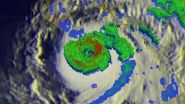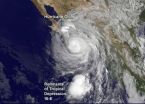(Press-News.org) VIDEO:
This animation of NOAA's GOES-West satellite imagery from Sept. 13 through Sept. 15 shows Hurricane Odile's movement and landfall near Cabo San Lucas on Mexico's Baja California. TRT 0:42...
Click here for more information.
NASA's Tropical Rainfall Measuring Mission satellite known as TRMM captured data on powerful Hurricane Odile revealing heavy rainfall from powerful thunderstorms as it made landfall in Baja California. Odile tied a record for strongest hurricane to hit the Baja in over 40 years.
Odile made landfall near Cabo San Lucas at 0445 UTC (12:45 a.m. EDT) and was moving northwest along the length of the peninsula of Baja California, then northeast to the northern end of the Sea of Cortez.
TRMM passed directly above hurricane Odile on September 15, 2014 at 0344 UTC (Sept. 14 at 1:44 p.m. EDT). That was about an hour before the strong hurricane hit Baja California near Cabo San Lucas.
NASA's TRMM Satellite measured rainfall in Odile on Sept. 15. Odile contained intense thunderstorms around the eye above 12.5 km (about 7.8 miles) high dropping rain at a rate of over 188.4 mm (about 7.4 inches) per hour.
The National Hurricane Center (NHC) hurricane discussion on September 15, 2014 said, "The estimated intensity of 110 knots at landfall ties Odile with Olivia (1967) as the strongest hurricane to make landfall in the satellite era in the state of Baja California Sur."
VIDEO:
NASA's TRMM Satellite measured rainfall in Odile on Sept. 15. Odile contained intense thunderstorms around the eye above 12.5 km (about 7.8 miles) high dropping rain at a rate of...
Click here for more information.
TRMM's Precipitation Radar (PR showed that Odile contained intense thunderstorms dropping rain at a rate of over 188.4 mm (about 7.4 inches) per hour in the hurricane's nearly circular eye wall.
One of the TRMM satellites most useful features has been its ability to provide vertical profiles of the rain and snow from the surface up to a height of about 12 miles (20 kilometers). At NASA's Goddard Space Flight Center in Greenbelt, Maryland a simulated 3-D view of Hurricane Odile's rainfall structure was created using the satellite's radar reflectivity data. This view showed that the tops of many intense thunderstorms in Odile's eye wall were reaching heights above 12.5 km (about 7.8 miles).
By 2 p.m. EDT on September 15, Hurricane Odile's wind speeds decreased to about 90 mph (150 kph) after hitting land and winds are forecast by the NHC to slowly decrease to below hurricane force tomorrow. Odile is moving to the northwest at 13 mph (20 kph). It was centered near 25.1 north and 111.6 west, about 45 miles (70 km) east-northeast of Cabo San Lazaro, Mexico.
Torrential rainfall is predicted to continue near the weakening system. Flash floods and landslides with rainfall totals of over 152-305 mm (6-12 inches) are predicted by the NHC as Odile travels over the Baja California Peninsula. Western Mexico is expected to feel the effects of Hurricane Odile today and tomorrow as the hurricane continues to hug the coast. A Hurricane Warning is in effect for Baja California Sur from Punta Abreojos to Santa Rosalia. A Hurricane Watch remains in effect for the west coast of Baja California Sur from north of Punta Abreojos to Punta Eugenia. A Tropical Storm Warning is in effect for the East Coast of the Baja Peninsula from north of Santa Rosalia to Bahia De Los Angeles, the west coast of the Baja Peninsula from north of Punta Eugenia to San Jose De Las Palomas and mainland Mexico from Altata to Bahia Kino.
A Tropical Storm Watch is in effect for the west coast of The Baja Peninsula North of San Jose De Las Palomas to Cabo San Quintin, the east coast of the Baja Peninsula From North of Bahia De Los Angeles to San Felipe and mainland Mexico from north of Bahia Kino to Puerto Libertad.
Although Odile continues to weaken heavy rainfall and flooding pose serious threats.
INFORMATION:
Hal Pierce / Rob Gutro
NASA's Goddard Space Flight Center
NASA's TRMM satellite sees Hurricane Odile strike Baja California
2014-09-15
ELSE PRESS RELEASES FROM THIS DATE:
IU study: Combining epilepsy drug, morphine can result in less pain, lower opioid doses
2014-09-15
INDIANAPOLIS -- Adding a common epilepsy drug to a morphine regimen can result in better pain control with fewer side effects. Moreover, the combination can reduce the dosage of the opioid needed to be effective, according to a team of pain researchers at Indiana University.
The result could bring significant relief to many patients with neuropathic pain, a difficult-to-treat condition often felt in the arms and legs and associated with nerve tissue damage.
"There is a huge unmet need for better treatments for neuropathic pain," said Fletcher A. White, Ph.D., the Vergil ...
'Squid skin' metamaterials project yields vivid color display
2014-09-15
The quest to create artificial "squid skin" -- camouflaging metamaterials that can "see" colors and automatically blend into the background -- is one step closer to reality, thanks to a breakthrough color-display technology unveiled this week by Rice University's Laboratory for Nanophotonics (LANP).
The new full-color display technology uses aluminum nanoparticles to create the vivid red, blue and green hues found in today's top-of-the-line LCD televisions and monitors. The technology is described in a new study that will be posted online this week in the Early Edition ...
Researchers discover new producer of crucial vitamin
2014-09-15
New research has determined that a single group of microorganisms may be responsible for much of the world's vitamin B12 production in the oceans, with implications for the global carbon cycle and climate change.
Although vitamin B12 is an essential molecule required by most life on this planet, it is only produced by a relatively small group of microorganisms because it is so large and complex. For humans, vitamin B12 plays a key role in maintaining the brain and nervous systems, as well as DNA synthesis in cells throughout the body.
Professors Andew Doxey and Josh ...
X-rays unlock a protein's SWEET side
2014-09-15
Sugar is a vital source of energy for both plants and animals alike.
Understanding just how sugar makes its way into the cell could lead to the design of better drugs for diabetes patients and an increase in the amount of fruits and vegetables farmers are able to grow. Stanford University researchers have recently uncovered one of these "pathways" into the cell by piecing together proteins slightly wider than the diameter of a strand of spider silk.
To determine the size, shape and orientation of one of the newest (and smallest) of these proteins, the sugar transporter, ...
Pitt chemical biologist finds new halogenation enzyme
2014-09-15
PITTSBURGH—Molecules containing carbon-halogen bonds are produced naturally across all kingdoms of life and constitute a large family of natural products with a broad range of biological activities. The presence of halogen substituents in many bioactive compounds has a profound influence on their molecular properties.
One of the Holy Grails in chemical science has been to find the late-stage, site-specific incorporation of a halogen atom into a complex natural product by replacing an sp³ C-H bond (one of the most inert chemical bonds known in an organic compound) with ...
Satellite sees Tropical Depression 16-E remnants scooped by Hurricane Odile
2014-09-15
At 11 p.m. EDT on Sunday, September 14, Tropical Depression 16-E was officially a remnant low pressure area. NOAA's GOES-West satellite showed the clouds associated with the remnants being drawn into the massive circulation of nearby Hurricane Odile.
At 5 a.m. on Sunday, September 14, Tropical Depression 16-E (TD 16-E) was still holding together despite being close to the circulation of Hurricane Odile. At that time, the center of tropical depression 16-E was located near latitude 14.9 north and longitude 115.3 west. That's about 655 miles (1,055 km) south-southwest ...
Satellites show Edouard's transition into an Atlantic Hurricane
2014-09-15
VIDEO:
This GOES-East satellite image animation of Edouard from Sept. 13 through 15 showed the storm consolidating. The eye of the hurricane became visible on and off during Sept. 14 in...
Click here for more information.
NASA's Terra satellite passed over Tropical Storm Edouard each day from September 12 through 14 and captured imagery of the storm as it grew into a hurricane. NOAA's GOES-East satellite covers the Atlantic Ocean and takes visible images during the day and infrared ...
NASA sees Typhoon Kalmaegi as a whirlpool of clouds in the South China Sea
2014-09-15
NASA's Aqua satellite observed Typhoon Kalmaegi crossing the South China Sea and a satellite image from the MODIS instrument aboard made it look like a whirlpool of clouds.
On Sunday, September 14, Kalmaegi passed over northern Luzon, Philippines and emerged into the South China Sea. Typhoon Kalmaegi's maximum sustained winds were near 65 knots (75 mph) making it a category one hurricane on the Saffir-Simpson scale as it moved over the Philippines.
On September 15 at 05:15 UTC (1:15 a.m. EDT) the Moderate Resolution Imaging Spectroradiometer aboard NASA's Aqua satellite ...
Number-crunching could lead to unethical choices, says new study
2014-09-15
Toronto – Calculating the pros and cons of a potential decision is a way of decision-making. But repeated engagement with numbers-focused calculations, especially those involving money, can have unintended negative consequences, including social and moral transgressions, says new study co-authored by a professor at the University of Toronto's Rotman School of Management.
Based on several experiments, researchers concluded that people in a "calculative mindset" as a result of number-crunching are more likely to analyze non-numerical problems mathematically and not take ...
Researchers develop improved means of detecting mismatched DNA
2014-09-15
Researchers at Johns Hopkins have identified a highly sensitive means of analyzing very tiny amounts of DNA. The discovery, they say, could increase the ability of forensic scientists to match genetic material in some criminal investigations. It could also prevent the need for a painful, invasive test given to transplant patients at risk of rejecting their donor organs and replace it with a blood test that reveals traces of donor DNA.
In a report in the September issue of The Journal of Molecular Diagnostics, the research team says laboratory tests already show that ...







